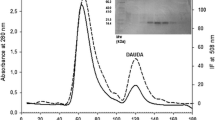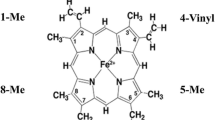Abstract
Binding affinity and binding-pocket polarity is determined for intracellular fatty acid- binding protein (FABP) from aerobic muscle of Chaenocephalus aceratus, the Antarctic icefish, and from rat heart. FABPs bind fatty acids via weak-bond forces (both ionic and hydrophobic), and these bond forces are temperature sensitive, yet FABPs are present in animals whose body temperatures range over nearly 40°C. To investigate FABPs sensitivity to body temperature, fatty acid binding affinity (Kd) was determined for both rat heart-FABP and icefish heart-FABP at two physiological temperatures (0°C or 37°C). Saturated and unsaturated fatty acids (16:0 and 16:1), delivered in model membranes (liposomes) whose composition is typical of either Antarctic fish (16:0/22:6 phosphatidylcholine) or mammals (bovine-heart phosphatidylcholine) were examined. Incubation at 0°C or 37°C does not significantly affect Kd for rat heart FABP, regardless of liposome composition or fatty acid ligand (Kd = 0.686 ± 0.127 – 1.129 ± 0.356 μM at 0°C, 0.775 ± 0.307 – 1.605 ± 0.427 gM at 37°C). Incubation temperature significantly affects icefish FABPs affinity for 16:1 (0.626 ± 0.093 μM at 37°C vs. 1.896 ± 0.343 μM at 0°C for fatty acid presented in Antarctic fish liposomes; 0.331 ± 0.101 μM at 37°C vs. 0.949 ± 0.121 μM at 0°C for bovine heart liposomes) but not 16:0. Kd is not significantly different between FABPs under any set of conditions (with one exception: Kd is significantly lower in rat FABP vs. icefish FABP for 16:0 at 0°C for fatty acids delivered in bovine heart liposomes). Although Kd values are largely equivalent between the two FABPs, relative contributions from ionic vs. hydrophobic weak-bond forces are different between the two animals. Rat heart FABP has a binding pocket that is significantly more nonpolar than that of icefish FABP (as measured by quantum yield of the bound fluorescent fatty-acid analogue (PA-DPH); Q = 0.067 ± 0.008 vs. 0.034 ± 0.005 at 0°C, 0.030 ± 0.003 vs. 0.019 ± 0.002 at 37°C). This suggests that rat-heart FABP realizes a micromolar Kd with a greater reliance upon hydrophobic interactions than does icefish FABP.
Similar content being viewed by others
References
Glatz JFC, Vork MM, Cistola DP, van der Vusse GJ: Cytoplasmic fatty acid-binding protein: Significance for intracellular transport of fatty acids and putative role on signal transduction pathways. Prostaglandins Leukotrienes and Essential Fatty Acids 48:3341, 1993
Veerkamp JH, Peeters RA, Maatman RGHJ: Structural and functional features of different types of cytoplasmic fatty acid-binding proteins. Biochim Biophys Acta 1081: 1–24, 1991
Sweetser DA, Heuckeroth RO, Gordon JI: The metabolic significance of mammalian fatty-acid-binding proteins: Abundant proteins in search of a function. Ann Rev Nutr 7: 337–359, 1987
Spener F, Börchers T: Structural and multifunctional properties of cardiac fatty acid-binding protein: from fatty acid binding to cell growth inhibition. Biochem Soc Trans 20: 806–811, 1992
Baier LJ, Sacchettini JC, Knowler WC, Eads J, Paolisso G, Tataranni PA, Mochizuki H, Bennett PH, Bogardus C, Prochazka M: An amino acid substitution in the human intestinal fatty acid-binding protein is associated with increased fatty acid binding, increased fat oxidation, and insulin resistance. J Clin Invest 95: 1281–1287, 1995
Richieri GV, Ogata RT, Kleinfeld AM: Equilibrium constants for the binding of fatty acids with fatty acid-binding proteins from adipocyte, intestine, heart, and liver measured with the fluorescent probe ADIFAB. J Biol Chem 269: 23918–23920, 1994
Londraville RL, Sidell BD: Purification and characterization of fatty acid-binding protein from aerobic muscle of the Antarctic icefish Chaenocephalus aceratus. J Exp Zool 273: 190–203, 1995
Stewart JM, Driedzic WR: Fatty acid binding proteins in teleost fish. Can J Zool 66: 2671–2675, 1988
Bass NM, Manning JA, Luer CA: Isolation and characterization of fatty acid binding protein in the liver of the nurse shark, Ginglymostoma cirratum. Comp Biochem Physiol 98A: 355–362, 1991
Matarese V, Stone RL, Waggoner DW, Bernlohr DA: Intracellular fatty acid trafficking and the role of cytosolic lipid binding proteins. Prog Lipid Res 28: 245–272, 1989
Zanotti G, Scapin G, Spadon P, Veerkamp JH, Sacchettini JC: Three-dimensional structure of recombinant human muscle fatty acid-binding protein J Biol Chem 267: 18541–18550, 1992
Schulenberg-Schell H, Schafer P, Keuper HJK, Stanislawski BS Hoffmann E, Rüterjans H, Spener F: Interactions of fatty acids with neutral fatty acid-bindng protein from bovine liver. Eur J Biochem 170: 565–574, 1988
Buelt MK, Bernlohr DA: Modification of the adipocyte lipid binding protein by sulfhydryl reagents and analysis of the fatty acid-binding domain. Biochem 29: 7408–7413, 1990
Franks F: Biophysics and biochemistry at low temperatures Cambridge University Press, 1985
Xu Z, Bernlohr DA, Banaszak LJ: The adipocyte lipid-binding protein at 1.6-Å resolution. Crystal structures of the apoprotein and with lipid bound saturated and unsaturated fatty acids. J Biol Chem 268: 7874–7884, 1993
Brecher P, Saouaf R, Sugarman JM, Eisenberg D, LaRosa K: Fatty acid transfer between multilamellar liposomes and fatty acid-binding proteins. J Biol Chem 259: 13395–13401, 1984
Kim H, Storch J: Mechanism of free fatty acid transfer from rat heart fatty acid-binding protein to phospholipid membranes. J Biol Chem 267: 20051–20056, 1992
Herr FM, Matarese V, Berhlohr DA, Storch J. Surface lysine residues modulate the collisional transfer of fatty acid from adipocyte fatty acid-binding protein to membranes.Biochemistry in press, 1995
Smith PK, Krohn RI, Hermanson GT, Mallia AK, Gartner FH, Provenzano MD, et al.: Measurement of protein using bicinchoninic acid. Anal Biochem 150: 76–85, 1985
Lowry OH, Rosebrough NJ, Farr AL, Randall RJ: Protein measurement with the folin phenol reagent. J Biol Chem 193: 265–275, 1951
Glatz JFC, Janssen AM, Baerwaldt CF, Veerkamp JH: Purification and characterization of fatty acid-binding proteins from rat heart and liver. Biochim Biophys Acta 837: 57–66, 1985
Parker CA, Rees WT: Correction of fluorescence spectra and measurement of fluorescence quantum efficiency. Analyst 85: 587–600, 1960
Velapoldi RA, Mielenz KD: A fluorescence standard reference material: Quinine sulfate dihydrate. Standard Reference Materials. US Dept Commerce, Nat Bur Stand. Jan, 1980
Trotter PJ, Storch J: 3-[p-(6-Phenyl)-1,3,5-hexatrienyl]pheynlpropionic acid (PA- DPH):characterization as a fluorescent membrane probe and binding to fatty acid-binding proteins. Biochim Biophys Acta 982: 131–139, 1989
Storch J: A comparison of heart and liver fatty acid-binding proteins: interactions with fatty acids and possible functional differences studied with fluorescent fatty acid analogues. Mol Cell Biochem 98: 141–147, 1990
Scott TG, Spencer RD, Leonard NJ, Weber G: Emission properties of NADH. Studies of fluorescence lifetimes and quantum efficiencies of NADH, AcPyADH, and simplified synthetic models. J Am Chem Soc 92: 687–695, 1970
Johnson ML: Why, when, and how biochemists should use least squares. Anal Biochem 206: 215–225, 1992
Campbell FD, Dwek DA: Biological Spectroscopy. Benjamin-Cummings Publishing, Menlo Park, CA, 1984
Peeters RA, In't Groen MA, Veerkamp JH: The fatty acid-binding protein from human skeletal muscle. Arch Biochem Biophy 274: 556–563, 1989
Said B, Schulz H: Fatty acid binding protein from rat heart. The fatty acid binding proteins from rat heart and liver are different proteins. J Biol Chem 259: 1155–1159, 1984
Jagshies G, Reers M, Unterberg C, Spener F: Bovine fatty acid binding proteins. Isolation and characterization of two cardiac fatty acid binding proteins that are distinct from corresponding hepatic proteins. Eur J Biochem 152: 537–545, 1985
Nemecz G, Hubbell T, Jefferson JR, Lowe JB, Schroeder F: Interaction of fatty acids with recombinant rat intestinal and liver fatty acid-binding proteins. Arch Biochem Biophy 286: 300–309, 1991
Richieri GV, Ogata RT, Kleinfeld AM: Thermodynamics of fatty acid binding to fatty acid-binding proteins and fatty acid partition between water and membranes measured using the fluorescent probe ADIFAB. J Biol Chem 270: 15076–15084, 1995
Paulussen RJA, van der Logt CPE, Veerkamp JH: Characterization and binding properties of fatty acid-binding proteins from Human, Pig, and Rat heart. Arch Biochem Biophy 264: 533–545, 1988
Maatman RGS, Degano M, van Moerkerk HTB, van Marrewuk WJA, van der Horst DJ, Sacchettini JC, Veerkamp JH: Primary structure and binding characteristics of locust and human muscle fatty-acidbinding proteins. Eur J Biochem 221: 801–810, 1994
Claffey KP, Herrera VL, Brecher P, Ruiz-Opazo N: Cloning and tissue distribution of rat heart fatty acid binding protein mRNA. Identical forms in heart and skeletal muscle. Biochem 26: 7900–7904, 1987
LaLonde JM, Levenson MA, Roe JJ, Bernlohr DA, Banaszak LJ: Adipocyte lipid-binding protein complexed with arachidonic acid. J Biol Chem 269: 25339–25347, 1994
Privalov PL, Gill SJ: The hydrophobic effect: a reappraisal. Pure and Appl Chem 61: 1097–1104, 1989
Storch J, Bass NM, Kleinfeld AM: Studies of the fatty acid-binding site of rat liver fatty acid- binding protein using fluorescent fatty acids. J Biol Chem 264: 8708–8713, 1989
Sacchettini JC, Gordon JI, Banaszak LJ: The structure of crystalline Escherichia coli-derived rat intestinal fatty acid-binding protein at 2.5 Å resolution. J Biol Chem 263: 5815–5819, 1988
Frieden C, Jiang N, Cistola, DP: Intestinal fatty acid binding protein: Folding of fluorescein- modified proteins. Biochemistry 34: 2724–2730, 1995
Jakoby MG, Miller KR, Toner JJ, Bauman A, Cheng L, Li E, Cistola DP: Ligand-protein electrostatic interactions govern the specificity of retinol- and fatty acid-binding proteins. Biochem 32: 872–878, 1993
Sha RS, Kane CD, Xu Z, Banaszak LJ, Bernlohr DA: Modulation of ligand binding affinity of the adipocyte lipid-binding protein by selective mutation. Analysis in vitro and in situ. J Biol Chem 268: 7885–7892, 1993
Storch J, Bass NM: Transfer of fluorescent fatty acids from liver and heart fatty acid-binding proteins to model membranes. J Biol Chem 265: 7827–7831, 1990
Wootan MG, Storch J: Regulation of fluorescent fatty acid transfer from adipocyte and heart fatty acid binding proteins by acceptor membrane lipid composition and structure. J Biol Chem 269: 10517–10523, 1994
Wootan MG, Bernlohr DA, Storch J: Mechanism of fluorescent fatty acid transfer from adipocyte fatty acid binding protein to membranes. Biochem 32: 8622–8627, 1993
Crockett EL, Sidell BD: Some pathways of energy metabolism are cold adapted in Antarctic fishes. Physiol Zool 63: 47288, 1990
Sidell BD, Crockett EL, Driedzic WR: Antarctic fish tissues preferentially catabolize monoenoic fatty acids. J Exp Zool 271: 73–81, 1995
Author information
Authors and Affiliations
Rights and permissions
About this article
Cite this article
Londraville, R.L., Storch, J. & Sidell, B.D. Binding site polarity and ligand affinity of homologous fatty acid-binding proteins from animals with different body temperatures. Mol Cell Biochem 159, 39–45 (1996). https://doi.org/10.1007/BF00226061
Received:
Accepted:
Issue Date:
DOI: https://doi.org/10.1007/BF00226061




